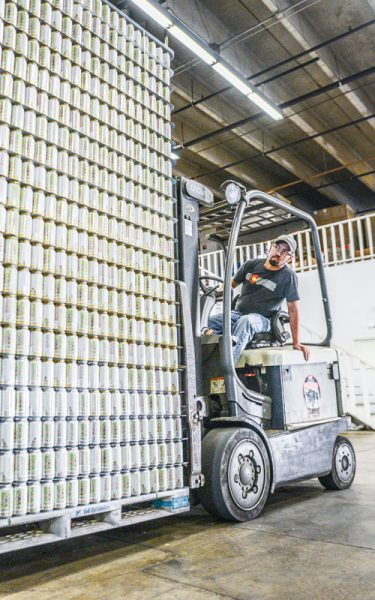Uncategorized
Bottles and cans: Craft Beer packaging trends in 2018
January 8, 2019By Bart Watson
At least once I year, I try to dive into packaging trends. Last year’s post focused on the growth in cans, and how that growth was being fueled by a fairly balanced mix of breweries shifting toward cans, and smaller breweries, who tend to use cans more, generally growing faster.
Although once again the headline of this year’s post is that craft continues its shift toward can packaging, this year, the data suggest that this is due more generally toward packaging shifts on the part of brewers, and less due to growth effects. In addition, unlike previous years where it was possible to argue that shifts into cans were potentially incremental to the craft category, as growth has slowed, it’s clearer that can growth is now coming at the expense of bottles.
Overall Packaging Growth
Most of the data in this post comes from IRI Groupscan data. For this data set, I’ve used the Brewers Association (BA) definition of “craft” across the total U.S. for their broadest channel (which is called multi-outlet plus convenience). As always, caveats apply about using scan data. The 2018 data runs through December 23, so it’s a bit less complete than previous years (to make the absolute numbers more comparable, I’ve estimated the final week of the year). I’ll also supplement with some Nielsen data which shows similar trends.
Let’s start with the headline percentages. Here’s the total volume of packaged products in cans and bottles from 2014-2018 scan data, as well as the percent those represent. As you can see, even though bottles were declining as a percent from 2014-2016, their absolute volume was still increasing. That pattern changed in 2017, and then accelerated in 2018. Some of this was likely due to the slowdown in distributed craft growth, but as you can see from the percentages, the shift toward cans also accelerated last year. Members who watched the Nielsen Power Hour in 2018 saw a similar story, and there is additional data there to compare (it’s also a great place to get some consumer insights on this shift).
20142015201620172018010,000,00020,000,00030,000,00040,000,00050,000,00060,000,00070,000,000Case Equivalents
BottlesCans
Drivers for the Packaging Shift
As mentioned in the introduction, last year can growth was a mix of growth effects and packaging shifts. Breaking down growth this year, it’s clear that can growth was primarily driven simply by packaging decisions. Although growth patterns played a role, almost 2/3 of the growth in cans in 2018 can be explained by packaging shifts.
New Brewers: 2.30%Interaction Effect: 2.40%Brewer Growth: 32.20%Packaging Decisions: 63.10%
A reminder on what these terms mean:
- Packaging decisions = changes in the packaging mix of individual brewers. So if a brewer made 100 barrels in 2017, 70 in bottles and 30 in cans, and then shifted to a 60-40 ratio in 2018 without a change in their total volume, that shows up here.
- Brewer growth = the shift to cans from growth effects. So if I brewers who are 100 percent in cans grow faster on average than a brewers who are 50 percent in cans, this is where that shows up. This comes from smaller brewers tending to grow faster.
- Interaction effect = a mix of the two drivers above. So brewers who are growing faster may also have shifted their mix more (or vice versa).
- New brewers = brewers who weren’t in the IRI set in 2017 and are in 2018. Even though they are a very small percentage of the overall change (and only represent 0.2 percent of BA craft scan volume in 2018), it’s worth spending a few sentences to discuss their data. Why? Their production was a whopping 95 percent cans (n = 122). So although they are a small piece of volume, I think this underlines the sea change we are seeing. Can you imagine 95 percent of new brewer volume in cans in 2014? I sure can’t.
Continuity in Packaging Mix
One quick diversion. When focusing on trends, it’s easy to over-state changes and ignore continuity. As I noted in 2017, 88.2 percent of brewers saw their packaging mix stay within 10 percent of where it was the previous year, and 66 percent saw zero change (mostly breweries that are 100 percent one or the other). 2018 was similar. 64 percent didn’t change their packaging mix at all (at least based on scan data), so most brewers didn’t change much at all in 2018. This makes a ton of sense, because the majority of brewers tend to have only one format.
Changes in Formats
Within bottles and cans, how did packaging change?
Bottles
Let’s start by looking at sizing. Bottles are dominated by 12oz bottles, and that trend actually strengthened slightly in 2018 (even if total bottle sales declined). Bottles of BA craft beer are 96 percent 12oz bottles, for example. That percentage might go down a bit if we had comprehensive data covering bottle shops/special releases, etc., but it’s clear that 12oz bottles dominate. The decline in 6-pack 12oz bottles and 12-pack 12oz bottles was roughly equivalent in percentage terms, with 6-packs still selling about 50 percent more in total volume (meaning they sell about 3 times as many units).
The epitaph of the 22oz bottle has already been written several times, and there were few signs of revival in 2018, as the percent of bottles in the 22oz format went from 2.4 percent in 2017 to 1.9 percent in 2018. That’s just above 1 percent of all packaged craft beer.
Cans
In cans, growth made the absolute numbers look great for basically every size format (95 percent of cans are 12oz or 16oz), while the percentages stayed fairly stable. One can size that saw very strong growth on a small base was 18-19oz cans, largely sold as single format. My assumption is that the majority are in the growing convenience channel. They reached 1.4 percent of total can sales in 2018 (up from 0.5 percent) and are now about half the size of 22oz bottles.
In terms of packaged units for cans, while everything grew, there was a share shift from 12-packs to 6-packs, mostly driven by 12oz cans. This was a result of 12-pack cans growing much more slowly than 6-pack cans (and other can formats). Although I haven’t delved too deeply into the why – my guess is that this is almost certainly a growth effect from smaller brewers, who are much less likely to have a 12-pack format.
credit:
January 8, 2019By Bart Watson
Source for article: https://www.brewersassociation.org/insights/bottles-and-cans-craft-beer-packaging-trends-in-2018/

